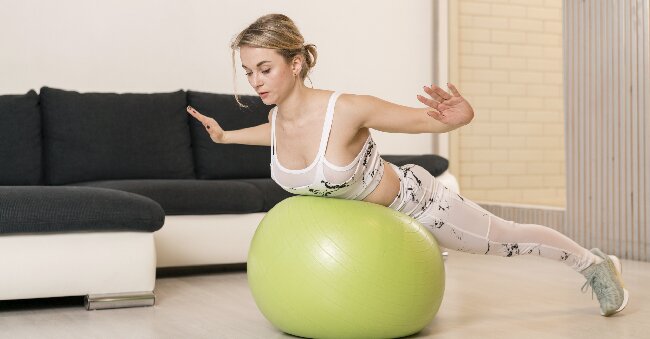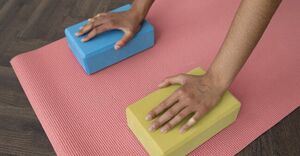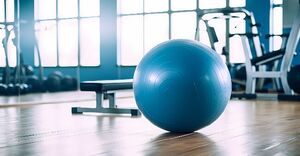
7 Essential Stability Ball Exercises for Total Body Toning
Are you interested in diversifying your workout regimen and achieving full-body toning? The stability ball may be the perfect solution for you. This adaptable piece of equipment provides numerous advantages, such as enhancing balance and coordination while targeting various muscle groups.
This article will delve into the reasons why integrating stability ball exercises into your routine is beneficial, how to select the appropriate size stability ball, and 7 crucial exercises to assist you in reaching your fitness objectives.
Let’s begin!
What Is a Stability Ball?
A Stability Ball, also known as an exercise ball or Swiss ball, is a versatile piece of fitness equipment used for various exercises that target different muscle groups. It is commonly used for core strengthening exercises and improving balance and stability.
The stability ball is a large, inflatable ball that comes in various sizes to accommodate different body types and fitness levels. Its round shape creates an unstable surface, which engages the core muscles to maintain balance during exercises. This instability forces the body to recruit smaller stabilizing muscles, leading to improved overall strength and coordination. The stability ball can be incorporated into a wide range of exercises, from basic crunches and planks to more advanced movements like squats and push-ups, making it a versatile tool for full-body workouts.
Why Use a Stability Ball for Exercise?
Incorporating a Stability Ball into a workout routine offers various benefits such as improving balance, enhancing core strength, and targeting multiple muscle groups simultaneously. Its effectiveness in toning muscles and increasing stability makes it a valuable addition to any fitness regimen.
Using a stability ball engages muscles that may not be activated during traditional exercises, leading to a more comprehensive workout. The unstable surface of the stability ball forces the body to recruit stabilizing muscles, improving overall balance and coordination. Stability ball workouts can help in preventing injuries by strengthening the core and improving posture. The versatility of the stability ball allows for a wide range of exercises, from basic movements to advanced variations, making it suitable for individuals at any fitness level.
1. Improves Balance and Coordination
Incorporating a Stability Ball in exercises can enhance balance and coordination by activating core muscles and engaging stabilizing muscles. This makes it a beneficial option for individuals, particularly beginners, looking to improve stability and reduce the risk of injuries as they advance in their fitness routines.
When starting stability ball exercises, it is crucial to emphasize proper posture and alignment during each movement. This not only effectively targets the core but also contributes to improved stability and balance.
Gradually increasing the exercise difficulty, such as by introducing balance challenges or using resistance bands, can further stimulate stabilizing muscles. It is advisable to begin with fundamental exercises like ball squats and planks before advancing to more complex movements to establish a solid foundation and minimize the likelihood of injuries.
2. Increases Core Strength
Stability Ball exercises are effective for enhancing core strength as they engage multiple muscle groups simultaneously. By including bodyweight exercises on the stability ball, individuals can enhance their strength training and activate muscles that are often overlooked in traditional workouts.
The dynamic nature of stability ball workouts challenges balance and stability, resulting in improved core strength. These exercises target not only the superficial muscles but also the deeper stabilizing muscles, promoting a stronger and more resilient core.
The versatility of the stability ball allows for various exercise variations, making it suitable for individuals of all fitness levels. Whether someone is a beginner looking to build foundational strength or an advanced athlete aiming to enhance power and stability, the stability ball can meet their specific needs.
3. Targets Multiple Muscle Groups
Utilizing a Stability Ball in a workout regimen enables the targeting of multiple muscle groups simultaneously, encouraging flexibility, resistance training, and functional fitness. The dynamic nature of stability ball exercises ensures comprehensive muscle engagement for a full-body workout.
By integrating stability ball exercises into a routine, one can activate core muscles, enhance balance, and improve proprioception. These exercises also challenge stabilizer muscles, resulting in enhanced strength and coordination. Whether performing planks, squats, or bridges on the stability ball, each movement engages different muscle groups, making it a versatile tool for a well-rounded workout.
Stability ball exercises can aid in injury prevention by strengthening muscles that support joints and promoting better posture.
What Size Stability Ball Should You Use?
Selecting the correct size Stability Ball is important for ensuring the effectiveness and safety of a workout routine. It is advised to choose a ball size that matches one’s height, fitness goals, and exercise preferences to prevent injuries and maintain proper form during exercises.
Height should be considered when selecting a Stability Ball; taller individuals typically benefit from larger sizes, while shorter individuals may find smaller options more suitable. Fitness level is also a crucial factor to consider, as beginners may prefer a bigger ball for added stability, whereas advanced users might opt for smaller sizes to intensify their workouts. The specific exercises planned should also be taken into account – medium-sized balls may be ideal for activities like yoga or Pilates, while larger balls are suitable for core strengthening exercises. It is important to note that choosing the right Stability Ball size is essential for a safe and effective workout experience.
How to Choose the Right Stability Ball for You?
When choosing a Stability Ball, it is important to consider factors such as fitness goals, preferred workout styles, and the type of exercises planned to be performed. Tailoring the selection to align with bodyweight training needs and muscle toning objectives can ensure optimal workout modification and effectiveness.
For individuals looking to improve core strength and stability, a stability ball with a textured surface can provide extra grip during exercises like planks and crunches. Those seeking variety and versatility in workouts may opt for a dual-sided stability ball that offers different levels of stability, providing a range of intensity options. Individuals focusing on balance and coordination might benefit from a burst-resistant stability ball that supports challenging balance exercises.
By choosing the appropriate stability ball that fits unique fitness objectives, individuals can enhance their bodyweight training routine and improve muscle tone effectively.
7 Essential Stability Ball Exercises for Total Body Toning
Incorporate the following 7 essential Stability Ball exercises into a workout routine for total body toning and muscle engagement. Each exercise, from Stability Ball Squats to Stability Ball Wall Sits, offers variations to challenge different muscle groups, improve form and technique, and cater to both beginners and advanced fitness enthusiasts.
Adding Stability Ball Push-ups to a routine can target the chest, shoulders, and triceps while engaging the core for stability.
For a lower body workout, trying Stability Ball Hamstring Curls can strengthen the hamstrings and glutes.
Balancing the regimen with Stability Ball Russian Twists can provide a challenging core workout.
To enhance upper body strength, consider incorporating Stability Ball Shoulder Presses.
It is important to maintain proper posture and core engagement throughout each exercise to maximize the benefits of stability ball training.
As progress is made, increasing the intensity by incorporating stability challenges and adding resistance with dumbbells or resistance bands can provide an advanced workout.
1. Stability Ball Squats
Stability Ball Squats are exercises that can help enhance core stability and tone the lower body. Including this exercise in a workout routine can improve workout effectiveness and contribute to a fitness transformation journey.
By adding Stability Ball Squats to a fitness regimen, multiple muscle groups are engaged simultaneously, leading to more efficient calorie burning and increased muscle definition. The unstable surface of the stability ball makes core muscles work harder to maintain balance, thereby strengthening core stability.
This exercise also aids in improving posture and overall balance, which can reduce the risk of injury during other physical activities. The dynamic nature of Stability Ball Squats challenges the body in new ways, making workouts more engaging and effective for achieving body sculpting goals.
2. Stability Ball Push-Ups
Stability Ball Push-Ups engage multiple muscle groups, leading to improved muscle definition and strength. Incorporating this exercise in a routine boosts workout motivation and provides inspiration for challenging fitness goals.
By targeting muscles across the chest, shoulders, arms, and core, Stability Ball Push-Ups offer a comprehensive workout that can help achieve a toned and defined physique. This exercise not only challenges strength but also balance and stability, elevating the intensity and effectiveness of training sessions. The instability of the ball requires muscles to work harder to maintain proper form, leading to increased muscle engagement and development. Seeing progress in performance with this exercise can serve as a motivator to push further and set ambitious fitness targets.
3. Stability Ball Plank
Engaging in a Stability Ball Plank can be a beneficial method for toning muscles and building core strength.
Incorporating Stability Ball Planks into a workout routine involves sculpting muscles while enhancing core strength. The instability of the ball necessitates increased engagement of core and stabilizing muscles, leading to a more impactful workout. This exercise presents a distinct challenge that encourages maintaining balance and control throughout the movement, fostering dedication to fitness goals. The continual effort to stabilize the body on the ball contributes to enhanced muscle tone and overall core stability.
4. Stability Ball Glute Bridges
Stability Ball Glute Bridges are effective for engaging the glutes and improving muscle activation. Including this exercise in a routine can enhance workout discipline and persistence by targeting specific muscle groups with controlled movements.
Utilizing a stability ball during glute bridges can increase the engagement of the glutes and core muscles. The unstable surface of the ball challenges stability, requiring the muscles to work harder to maintain balance. This heightened activation results in greater muscle tone and strength development in the lower body. The controlled movements necessary during stability ball glute bridges also aid in improving overall body awareness and posture. This exercise is a beneficial addition to any workout routine aiming to enhance glute activation and muscle tone.
5. Stability Ball Russian Twists
Engage the core muscles and obliques with Stability Ball Russian Twists to enhance workout persistence and perseverance. This exercise targets key muscle groups and promotes consistent workout performance.
The Stability Ball Russian Twists provide a dynamic way to challenge the core and oblique muscles, aiding in building strength and stability. By including this exercise in your routine, you can improve balance and posture, crucial for overall fitness progress. The twisting motion activates deep core muscles, improving the body’s ability to stabilize and control movement during various exercises. Regular practice of Stability Ball Russian Twists can enhance endurance and functional strength for a comprehensive fitness regimen.
6. Stability Ball Hamstring Curls
Enhance hamstring strength and muscle development with Stability Ball Hamstring Curls. Adding this exercise to your routine can increase workout motivation and offer inspiration for ongoing muscle development and toning.
This exercise specifically targets the hamstring muscles while involving stabilizing muscles in the core and lower body, promoting overall strength and balance. By including Stability Ball Hamstring Curls in your workout routine, you can achieve improved muscle definition and functional fitness.
The dynamic nature of this exercise provides a unique challenge to your body, making your workouts engaging and effective. As you notice your hamstrings becoming stronger and more toned, it can serve as a motivating factor to push yourself further in your fitness journey.
7. Stability Ball Wall Sits
Improve lower body endurance and stability by trying Stability Ball Wall Sits, which can help maintain workout consistency and frequency. This exercise targets leg muscles and boosts endurance levels, contributing to overall fitness progress.
By including Stability Ball Wall Sits in your routine, you can challenge your muscles to improve strength and endurance gradually. The exercise involves holding a seated position against the stability ball’s resistance, leading to increased muscle engagement due to the duration of the hold. With regular practice, you may observe enhanced ability to maintain proper form and stability, ultimately improving your workout performance.
How to Incorporate Stability Ball Exercises into Your Workout Routine?
Incorporating Stability Ball exercises into a workout routine can enhance workout intensity, frequency, and overall progress toward fitness goals. Regularly including these exercises can aid in muscle development, stability improvement, and enhancements in the fitness journey.
To smoothly integrate Stability Ball exercises, one can consider replacing traditional strength training exercises with Stability Ball variations. For example, swapping out standard squats with Stability Ball squats can engage more stabilizing muscles. Performing core exercises like planks or bridges on the Stability Ball can challenge balance and core strength. It is recommended to include at least 2-3 Stability Ball exercises in each workout session to maintain consistency and maximize benefits. Consistency plays a vital role in fitness progress, so gradually increasing the intensity and difficulty of Stability Ball exercises as one progresses is advisable.
Safety Tips for Using a Stability Ball
Safety is a top priority when using a Stability Ball. It is important to follow essential guidelines to prevent injuries and ensure workout safety. Consistent adherence to safety tips, such as maintaining proper form and controlling workout duration, is crucial for achieving fitness success and avoiding potential risks during stability ball exercises.
Establishing a strong foundation is crucial. This includes selecting a stability ball that suits your height and weight, ensuring it is properly inflated, and placing it on a flat, non-slip surface. To enhance safety, start with basic exercises and gradually progress to more advanced moves as your strength and balance improve. Incorporating core-strengthening exercises, like planks and stability ball crunches, can help prevent injuries by improving stability and promoting better posture.
It is also important to listen to your body, take breaks when needed, and consider consulting a fitness professional for personalized guidance.




No Comments